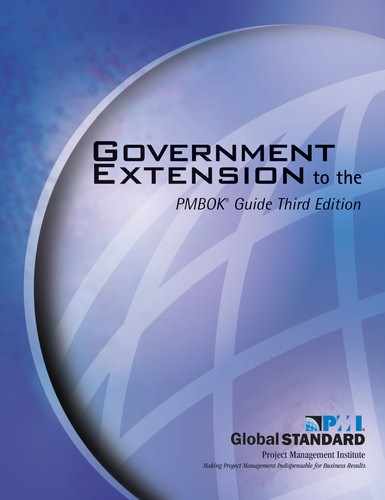Chapter 6
Project Time Management
See the introduction to Chapter 6 in the PMBOK® Guide—Third Edition.
6.1 Activity Definition
See Section 6.1 of the PMBOK® Guide—Third Edition.
6.2 Activity Sequencing
See Section 6.2 of the PMBOK® Guide—Third Edition.
6.3 Activity Resource Estimating
See Section 6.3 of the PMBOK® Guide—Third Edition.
6.4 Activity Duration Estimating
See Section 6.4 of the PMBOK® Guide—Third Edition.
6.4.1 Activity Duration Estimating: Inputs
See Sections 6.4.1.1 through 6.4.1.5 of the PMBOK® Guide—Third Edition.
- .6 Activity Resource Requirements
In government projects, the availability of skilled human resources (see Section 9.1.1.1 of this document) or other resources may be impacted by preference laws (see Section 12.4.2.8 of this document).
See Sections 6.4.1.1 through 6.4.1.8 of the PMBOK® Guide—Third Edition.
6.4.2 Activity Duration Estimating: Tools and Techniques
See Section 6.4.2 of the PMBOK® Guide—Third Edition.

6.4.3 Activity Duration Estimating: Outputs
See Section 6.4.3 of the PMBOK® Guide—Third Edition.
6.5 Schedule Development
See Section 6.5 of the PMBOK® Guide—Third Edition.
6.5.1 Schedule Development: Inputs
- .1 Organizational Process Assets
See Section 6.5.1.1 of the PMBOK® Guide—Third Edition.
- .2 Project Scope Statement
In addition to the inputs described in Section 6.5.1.2 of the PMBOK® Guide—Third Edition, the annual budget cycle is a unique, and often most difficult, constraint for government projects. Budgets are typically for one fiscal year at a time. This means that projects and programs often must be divided into one-year slices. Use it or lose it provisions generally require funds to be spent by the end of the fiscal year. Project delays can cause the loss of funding if work moves from one fiscal year into the next. Fortunately, funds are generally appropriated to programs rather than individual projects (see Section 1.6 of this document). Effective program managers can often move funds between projects to minimize the overall loss of funding. However, some very large projects keep their budgetary identity. No movement of funds to or from one of these projects can be processed without clearance by the government or those to whom the government has delegated that authority.
- .3 Activity List
See Section 6.5.1.3 of the PMBOK® Guide—Third Edition.
- .4 Activity Attributes
See Section 6.5.1.4 of the PMBOK® Guide—Third Edition.
- .5 Project Schedule Network Diagrams
See Section 6.5.1.5 of the PMBOK® Guide—Third Edition.
- .6 Activity Resource Requirements
See Section 6.5.1.6 of the PMBOK® Guide—Third Edition.
- .7 Resource Calendars
See Section 6.5.1.7 of the PMBOK® Guide—Third Edition.
- .8 Activity Duration Estimates
See Section 6.5.1.8 of the PMBOK® Guide—Third Edition.
- .9 Project Management Plan
See Section 6.5.1.9 of the PMBOK® Guide—Third Edition.
- .10 Line-Item Projects
These projects are added to the budget by the representative body on a project-by-project basis. They often are not supported by a proposal from the executive (see Section 2.1.2). The representatives set their schedules and budget. As a result, these projects may have poorly defined scopes, inadequate funding, or unreasonable schedules. The project manager must work with the customer expeditiously to determine the scope of work and the appropriate acquisition strategy to accomplish the project within the time constraints.
6.5.2 Schedule Development: Tools and Techniques
See Sections 6.5.2.1 through 6.5.2.10 of the PMBOK® Guide—Third Edition.
In addition to these tools and techniques, another, which is common in government projects, is described below:
- .11 Obligations
Obligations or encumbrances help to address the annual budget cycle constraint (see Section 6.5.1.2). They are useful on projects with large procurements, but can be used only if the representative body enacts rules to make them possible. Some governments can obligate the funds if they are contractually committed before the end of the fiscal year. An obligation places the contract funds into a separate account that can be used only for the specific contract. The funds remain available for additional years, depending upon the rules set by the government body. This technique avoids the need to appropriate funds in each fiscal year. Obligations are also used in intergovernmental agreements, sometimes called government transfer payments.
6.5.3 Schedule Development: Outputs
See Section 6.5.3 of the PMBOK® Guide—Third Edition.
6.6 Schedule Control
See Section 6.6 of the PMBOK® Guide—Third Edition.
